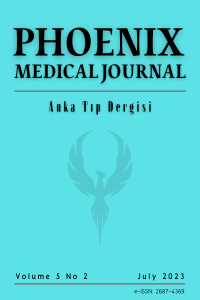Abstract
Amaç: Pulmoner emboli teşhis edilemediğinde yüksek ölüm oranı ile ilişkilidir. Amacımız fibrinojen/albümin oranı ile pulmoner emboli arasındaki ilişkiyi araştırmaktı.
Gereç ve Yöntem: PE olduğundan şüphelenilen ve rutin kan testi yapılan hastalar bu prospektif çalışmaya dahil edilmiştir. Fibrinojenleri ve albümin değerleri değerlendirildi.
Bulgular: Çalışmaya toplam 130 hasta dahil edildi. PE, hastaların 71’inde (%54) tespit edildi. Bunlardan 7’si (%9,9) subsegmental, 50’si (%70,4) segmental ve 14’ü (%19,7) masif idi. Kontrol grubundaki deneklerin FAR(Fibrinojen albumin oranı) ‘si 99.1 (75.2–167.9) iken, PE grubundaki FAR 151 (125.1–220.5) olup, kontrol grubundan anlamlı derecede yüksekti (P < 0,001). PE grubunda ROC analizi yapıldığında FAR önemli bir öngörücü faktör oldu (AUC: 0.724; %95 GA = 0.635-0.814; P < 0.001). FAR, duyarlılık %77.5 ve özgüllük %61.0 idi.
Sonuç: PE’li hastalarda fibrinojen düzeyleri ve FAR anlamlı olarak daha yüksekti.
Supporting Institution
ADNAN MENDERES ÜNİVERSİTY
Project Number
TPF-17043
References
- Dirican N, Duman A, Sağlam G, Arslan A, Ozturk O, Atalay S, et al. The diagnostic significance of signal peptide-complement C1r/C1s, Uegf, and Bmp1-epidermal growth factor domain-containing protein-1 levels in pulmonary embolism. Ann Thorac Med. 2016;11(4):277-282.
- Essien EO, Rali P, Mathai SC. Pulmonary Embolism. Med Clin North Am. 2019;103(3):549-564.
- Laporte S, Mismetti P, Décousus H, Uresandi F, Otero R, Lobo JL, et al. Clinical predictors for fatal pulmonary embolism in 15,520 patients with venous thromboembolism: Findings from the Registro Informatizado de la Enfermedad TromboEmbolica venosa (RIETE) Registry. Circulation. 2008;117:1711– 16.
- Aujesky D, Jiménez D, Mor MK, Geng M, Fine MJ, Ibrahim SA. Weekend versus weekday admission and mortality after acute pulmonary embolism. Circulation. 2009;119(7):962-8.
- Bithel TC. Blood coagulation. In: Lee GR, Bithell TC et al. Wintrobes Clinical Hematology, 9th ed. Philadelphia Lea Febiger. 1993;1:568-70.
- Infusino I, Panteghini M. Serum albumin: accuracy and clinical use. Clin Chim Acta. 2013;419:15-8.
- Kline JA, Courtney DM, Kabrhel C, Moore CL, Smithline HA, Plewa MC, et al. Prospective multicenter evaluation of the pulmonary embolism rule out criteria. J Thromb Haemost. 2008;6:772.
- Le Gal G, Righini M, Roy PM, Sanchez O, Aujesky D, Bounameaux H, et al. Prediction of pulmonary embolism in the emergency department: the revised Geneva score. Ann Intern Med. 2006;144(3):165–71.
- Wells PS, Anderson DR, Rodger M, Ginsberg JS, Kearon C, Gent M, et al. Derivation of a simple clinical model to categorize patients’ probability of pulmonary embolism: Increasing the model’s utility with the SimpliRED D-dimer. Thromb Haemost. 2000;83 (3):416–20.
- Konstantinides SV, Torbicki A, Agnelli G, Danchin N, Fitzmaurice D, Galiè N, et al. 2014 ESC Guidelines on the diagnosis and management of acute pulmonary embolism: The task force for the diagnosis and management of acute pulmonary embolism of the European Society of Cardiology (ESC) endorsed by the European Respiratory Society (ERS). Eur Heart J. 2014;35(43):3033-73.
- Karahan O, Acet H, Ertaş F, Tezcan O, Çalişkan A, Demir M, et al. The relationship between fibrinogen to albumin ratio and severity of coronary artery disease in patients with STEMI. Am J Emerg Med. 2016;34(6):1037-42.
- Demir M, Özbek M, Aktan A, Ertaş F. Fibrinogen to Albumin Ratio Predicts Burden of Coronary Artery Disease in Patients with NSTEMI. Dicle Med J. 2021;48(4):688-695.
- Kuyumcu MS, Aydın O. Fibrinogen-to-albumin ratio may be a predictor for ascending aortic aneurysm. Rev Assoc Med Bras. 2021;67(6):868-872.
- Xu Q, Yan Y, Gu S, Mao K, Zhang J, Huang P, et al. A Novel Inflammation-Based Prognostic Score: The Fibrinogen/Albumin Ratio Predicts Prognoses of Patients after Curative Resection for Hepatocellular Carcinoma. J Immunol Res. 2018;2018:e4925498.
- Sun F, Tan YA, Gao QF, Li SQ, Zhang J, Chen QG, et al. Circulating fibrinogen to pre-albumin ratio is a promising biomarker for diagnosis of colorectal cancer. J Clin Lab Anal. 2019;33(1):e22635.
- Yang WM, Zhang WH, Ying HQ, Xu YM, Zhang J, Min QH. Two new inflammatory markers associated with disease activity score-28 in patients with rheumatoid arthritis: Albumin to fibrinogen ratio and C-reactive protein to albumin ratio. International Immunopharmacology. 2018, 293-298.
Abstract
Objective: Pulmonary embolism is associated with a high mortality rate when it is not diagnosed emergently. Our aim was to investigate the relationship between the fibrinogen/albumin ratio and pulmonary embolism.
Material and Method: Patients who were suspected to have pulmonary embolism and who underwent routine blood testing to initiate the diagnostic process were included in this prospective study. Their fibrinogen and albumin values were evaluated.
Results: A total of 130 patients were included in the study. Pulmonary embolism was detected in 71 (54%) of the patients. Of those, 7 (9.9%) were subsegmental, 50 (70.4%) were segmental, and 14 (19.7%) were massive pulmonary. The fibrinogen/albumin ratio of the subjects in the control group was 99.1 (75.2–167.9), whereas the fibrinogen/albumin ratio in the pulmonary embolism group was 151 (125.1–220.5), significantly higher than the control value (P < 0.001). When ROC analysis was performed in the pulmonary embolism group, the fibrinogen/ albumin ratio was found to be a significant predictive factor (AUC: 0.724; 95% CI = 0.635–0.814; P < 0.001). When the fibrinogen/albumin ratio was 119.3, the sensitivity was 77.5%, and specificity was 61.0%.
Conclusion: Fibrinogen levels and fibrinogen/albumin ratio were significantly higher in patients with pulmonary embolism.
Keywords
Pulmonary embolism fibrinogen/albumin ratio mean platelet volume Pulmoner emboli fibrinojen/albümin oranı ortalama trombosit hacmi
Project Number
TPF-17043
References
- Dirican N, Duman A, Sağlam G, Arslan A, Ozturk O, Atalay S, et al. The diagnostic significance of signal peptide-complement C1r/C1s, Uegf, and Bmp1-epidermal growth factor domain-containing protein-1 levels in pulmonary embolism. Ann Thorac Med. 2016;11(4):277-282.
- Essien EO, Rali P, Mathai SC. Pulmonary Embolism. Med Clin North Am. 2019;103(3):549-564.
- Laporte S, Mismetti P, Décousus H, Uresandi F, Otero R, Lobo JL, et al. Clinical predictors for fatal pulmonary embolism in 15,520 patients with venous thromboembolism: Findings from the Registro Informatizado de la Enfermedad TromboEmbolica venosa (RIETE) Registry. Circulation. 2008;117:1711– 16.
- Aujesky D, Jiménez D, Mor MK, Geng M, Fine MJ, Ibrahim SA. Weekend versus weekday admission and mortality after acute pulmonary embolism. Circulation. 2009;119(7):962-8.
- Bithel TC. Blood coagulation. In: Lee GR, Bithell TC et al. Wintrobes Clinical Hematology, 9th ed. Philadelphia Lea Febiger. 1993;1:568-70.
- Infusino I, Panteghini M. Serum albumin: accuracy and clinical use. Clin Chim Acta. 2013;419:15-8.
- Kline JA, Courtney DM, Kabrhel C, Moore CL, Smithline HA, Plewa MC, et al. Prospective multicenter evaluation of the pulmonary embolism rule out criteria. J Thromb Haemost. 2008;6:772.
- Le Gal G, Righini M, Roy PM, Sanchez O, Aujesky D, Bounameaux H, et al. Prediction of pulmonary embolism in the emergency department: the revised Geneva score. Ann Intern Med. 2006;144(3):165–71.
- Wells PS, Anderson DR, Rodger M, Ginsberg JS, Kearon C, Gent M, et al. Derivation of a simple clinical model to categorize patients’ probability of pulmonary embolism: Increasing the model’s utility with the SimpliRED D-dimer. Thromb Haemost. 2000;83 (3):416–20.
- Konstantinides SV, Torbicki A, Agnelli G, Danchin N, Fitzmaurice D, Galiè N, et al. 2014 ESC Guidelines on the diagnosis and management of acute pulmonary embolism: The task force for the diagnosis and management of acute pulmonary embolism of the European Society of Cardiology (ESC) endorsed by the European Respiratory Society (ERS). Eur Heart J. 2014;35(43):3033-73.
- Karahan O, Acet H, Ertaş F, Tezcan O, Çalişkan A, Demir M, et al. The relationship between fibrinogen to albumin ratio and severity of coronary artery disease in patients with STEMI. Am J Emerg Med. 2016;34(6):1037-42.
- Demir M, Özbek M, Aktan A, Ertaş F. Fibrinogen to Albumin Ratio Predicts Burden of Coronary Artery Disease in Patients with NSTEMI. Dicle Med J. 2021;48(4):688-695.
- Kuyumcu MS, Aydın O. Fibrinogen-to-albumin ratio may be a predictor for ascending aortic aneurysm. Rev Assoc Med Bras. 2021;67(6):868-872.
- Xu Q, Yan Y, Gu S, Mao K, Zhang J, Huang P, et al. A Novel Inflammation-Based Prognostic Score: The Fibrinogen/Albumin Ratio Predicts Prognoses of Patients after Curative Resection for Hepatocellular Carcinoma. J Immunol Res. 2018;2018:e4925498.
- Sun F, Tan YA, Gao QF, Li SQ, Zhang J, Chen QG, et al. Circulating fibrinogen to pre-albumin ratio is a promising biomarker for diagnosis of colorectal cancer. J Clin Lab Anal. 2019;33(1):e22635.
- Yang WM, Zhang WH, Ying HQ, Xu YM, Zhang J, Min QH. Two new inflammatory markers associated with disease activity score-28 in patients with rheumatoid arthritis: Albumin to fibrinogen ratio and C-reactive protein to albumin ratio. International Immunopharmacology. 2018, 293-298.
Details
| Primary Language | English |
|---|---|
| Subjects | Emergency Medicine |
| Journal Section | Research Articles |
| Authors | |
| Project Number | TPF-17043 |
| Publication Date | July 1, 2023 |
| Submission Date | November 10, 2022 |
| Acceptance Date | February 10, 2023 |
| Published in Issue | Year 2023 Volume: 5 Issue: 2 |

Phoenix Medical Journal is licensed under a Creative Commons Attribution 4.0 International License.
Phoenix Medical Journal has signed the Budapest Open Access Declaration.



